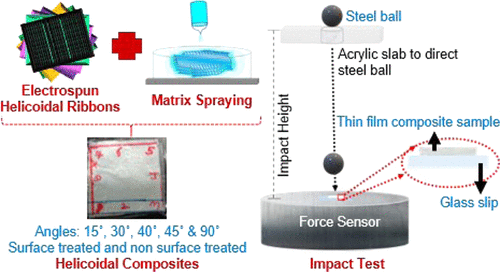当前位置:
X-MOL 学术
›
ACS Appl. Polym. Mater.
›
论文详情
Our official English website, www.x-mol.net, welcomes your
feedback! (Note: you will need to create a separate account there.)
Impact-Resistant and Tough Helicoidally Aligned Ribbon Reinforced Composites with Tunable Mechanical Properties via Integrated Additive Manufacturing Methodologies
ACS Applied Polymer Materials ( IF 4.4 ) Pub Date : 2020-07-01 , DOI: 10.1021/acsapm.0c00518 Komal Agarwal 1 , Rahul Sahay 1 , Avinash Baji 2 , Arief S. Budiman 1
ACS Applied Polymer Materials ( IF 4.4 ) Pub Date : 2020-07-01 , DOI: 10.1021/acsapm.0c00518 Komal Agarwal 1 , Rahul Sahay 1 , Avinash Baji 2 , Arief S. Budiman 1
Affiliation

|
Strong and tough structural materials occurring in nature have long fueled the search for an advanced class of strong biomimetic synthetic structural materials (SSMs). One such example in recent years is the rapid progress associated with the naturally occurring helicoidal composite structures inspiring the development of the tough helicoidally architectured synthetic structural composites (HA-SSCs). Most of the tough HA-SSCs have been fabricated using conventional composite resins and fibers or modern three-dimensional (3D) printing materials. Only recently, we ventured further into expanding the possibilities of imitating the helicoidal architecture in smaller scales (microns and tens of microns) while exploring the possibilities of utilization of various polymer-based composite formulas. In our previous research articles, we had established near-field electrospinning as an additive manufacturing methodology to construct tough and resilient 3D helicoidal membranes with micron-sized polymer fibers. In this article, we advance to the next level of developing fully composite structures from electrospun helicoidally assembled microribbons. A key aspect explored in this article is the importance of surface treatment. The physical, thermal, and mechanical experiments indicated superior adhesion between the components of composites, which led to enhanced toughness and impact properties. We further affirmed that reducing the helicoidal angular orientation of ribbons in the HA-SSCs can help further enhance the specific toughness and impact resistance of these composites. Furthermore, we found that the mechanical and physical properties of these composites can be tuned via several architectural features (helicoidal rotational angles, interface characteristics between layers and between ribbons) to suit the different strain-rate needs for various applications (combat army vest, sports gears such as helmets, flexible piezoelectric sensors, or polycarbonate-based solar photovoltaics (PV) modules). The experimental findings here suggest the importance of interfacial characteristics (between layers and between ribbons), the ribbon-to-matrix ratio, and angular arrangement of the ribbons as design guidelines for achieving next-generation HA-SSC materials, which are not only strong but also extremely tough and impact-resistant.
中文翻译:

通过集成的增材制造方法,具有可调节机械性能的耐冲击且韧性强的螺旋排列的碳带增强复合材料
自然界中存在的坚韧结构材料长期以来一直推动着对高级仿生合成结构材料(SSM)的寻求。近年来的一个这样的例子是与自然发生的螺旋复合结构相关的快速进步,激发了坚韧的螺旋结构合成结构复合材料(HA-SSC)的发展。大多数坚韧的HA-SSC都是使用常规的复合树脂和纤维或现代的3D打印材料制成的。直到最近,我们才进一步冒险扩大在更小规模(微米和数十微米)内模仿螺旋结构的可能性,同时探索利用各种基于聚合物的复合配方的可能性。在我们以前的研究文章中,我们已经建立了近场静电纺丝作为增材制造方法,以使用微米级的聚合物纤维构造坚韧而有弹性的3D螺旋膜。在本文中,我们将进一步提高由静电纺丝螺旋组装的微带开发完全复合结构的水平。本文探讨的一个关键方面是表面处理的重要性。物理,热和机械实验表明,复合材料各组分之间具有优异的粘合性,从而提高了韧性和冲击性能。我们进一步确认,减少HA-SSC中带材的螺旋角取向可以帮助进一步增强这些复合材料的比韧性和抗冲击性。此外,我们发现,这些复合材料的机械和物理性能可以通过几种建筑特征(螺旋旋转角,层之间以及条带之间的界面特性)进行调整,以适应各种应用(作战背心,运动装备等)的不同应变率需求。例如头盔,柔性压电传感器或基于聚碳酸酯的太阳能光伏(PV)模块)。此处的实验结果表明,界面特性(层间和色带之间),色带与基质的比率以及色带的角度排列的重要性,是实现下一代HA-SSC材料的设计准则,不仅坚固但也非常坚韧和抗冲击。层之间以及碳带之间的界面特性)以适应各种应用(作战背心,头盔等运动装备,柔性压电传感器或基于聚碳酸酯的太阳能光伏(PV)模块)的不同应变率需求。此处的实验结果表明,界面特性(层间和色带之间),色带与基质的比率以及色带的角度排列的重要性,是实现下一代HA-SSC材料的设计准则,不仅坚固但也非常坚韧和抗冲击。层之间以及碳带之间的界面特性)以适应各种应用(作战背心,头盔等运动装备,柔性压电传感器或基于聚碳酸酯的太阳能光伏(PV)模块)的不同应变率需求。此处的实验结果表明,界面特性(层间和色带之间),色带与基质的比率以及色带的角度排列的重要性,是实现下一代HA-SSC材料的设计准则,不仅坚固但也非常坚韧和抗冲击。
更新日期:2020-08-14
中文翻译:

通过集成的增材制造方法,具有可调节机械性能的耐冲击且韧性强的螺旋排列的碳带增强复合材料
自然界中存在的坚韧结构材料长期以来一直推动着对高级仿生合成结构材料(SSM)的寻求。近年来的一个这样的例子是与自然发生的螺旋复合结构相关的快速进步,激发了坚韧的螺旋结构合成结构复合材料(HA-SSC)的发展。大多数坚韧的HA-SSC都是使用常规的复合树脂和纤维或现代的3D打印材料制成的。直到最近,我们才进一步冒险扩大在更小规模(微米和数十微米)内模仿螺旋结构的可能性,同时探索利用各种基于聚合物的复合配方的可能性。在我们以前的研究文章中,我们已经建立了近场静电纺丝作为增材制造方法,以使用微米级的聚合物纤维构造坚韧而有弹性的3D螺旋膜。在本文中,我们将进一步提高由静电纺丝螺旋组装的微带开发完全复合结构的水平。本文探讨的一个关键方面是表面处理的重要性。物理,热和机械实验表明,复合材料各组分之间具有优异的粘合性,从而提高了韧性和冲击性能。我们进一步确认,减少HA-SSC中带材的螺旋角取向可以帮助进一步增强这些复合材料的比韧性和抗冲击性。此外,我们发现,这些复合材料的机械和物理性能可以通过几种建筑特征(螺旋旋转角,层之间以及条带之间的界面特性)进行调整,以适应各种应用(作战背心,运动装备等)的不同应变率需求。例如头盔,柔性压电传感器或基于聚碳酸酯的太阳能光伏(PV)模块)。此处的实验结果表明,界面特性(层间和色带之间),色带与基质的比率以及色带的角度排列的重要性,是实现下一代HA-SSC材料的设计准则,不仅坚固但也非常坚韧和抗冲击。层之间以及碳带之间的界面特性)以适应各种应用(作战背心,头盔等运动装备,柔性压电传感器或基于聚碳酸酯的太阳能光伏(PV)模块)的不同应变率需求。此处的实验结果表明,界面特性(层间和色带之间),色带与基质的比率以及色带的角度排列的重要性,是实现下一代HA-SSC材料的设计准则,不仅坚固但也非常坚韧和抗冲击。层之间以及碳带之间的界面特性)以适应各种应用(作战背心,头盔等运动装备,柔性压电传感器或基于聚碳酸酯的太阳能光伏(PV)模块)的不同应变率需求。此处的实验结果表明,界面特性(层间和色带之间),色带与基质的比率以及色带的角度排列的重要性,是实现下一代HA-SSC材料的设计准则,不仅坚固但也非常坚韧和抗冲击。











































 京公网安备 11010802027423号
京公网安备 11010802027423号